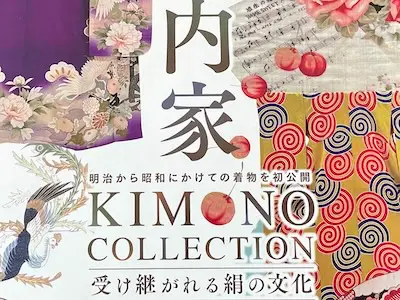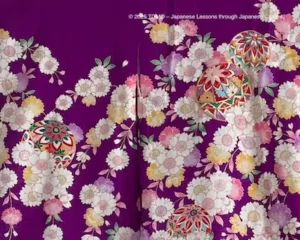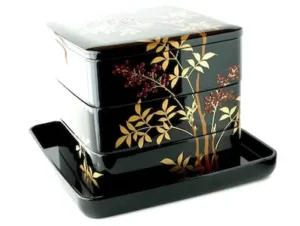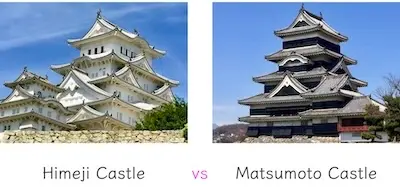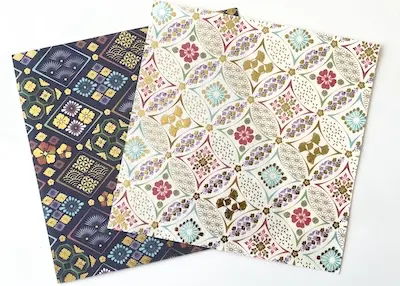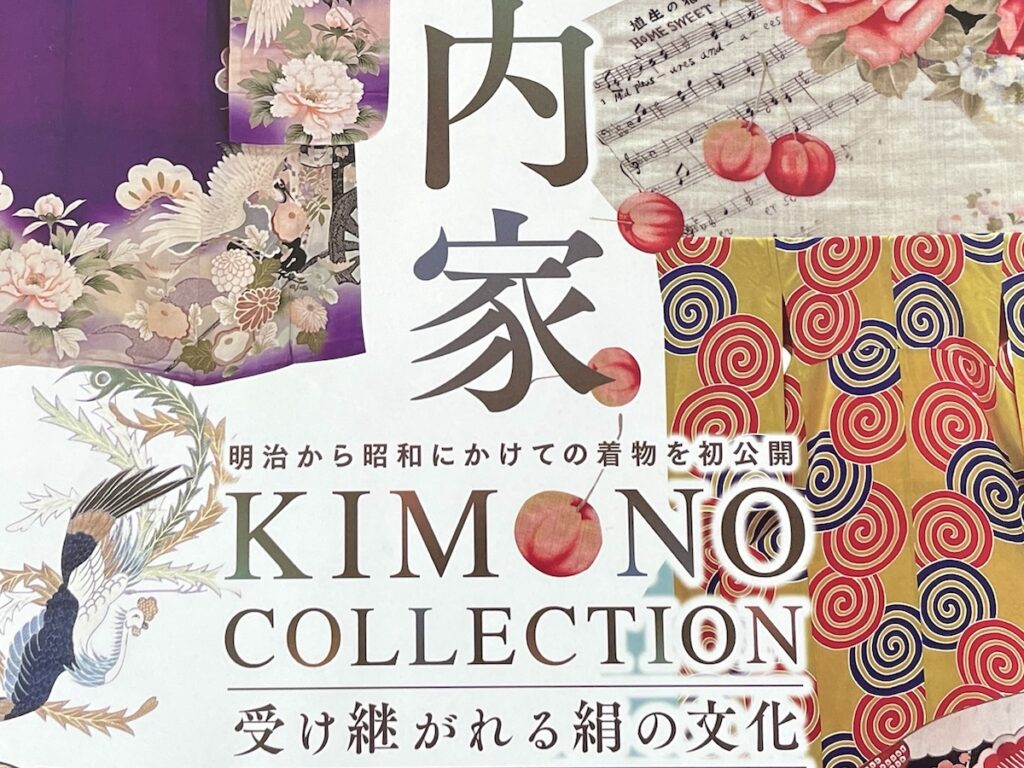
Kimono Collection Japan: Silk Fact Okaya’s Historic Exhibition
Meiji, Taisho, and Showa Era Kimon
Recently, I visited the exhibition KIMONO COLLECTION: The Legacy of Silk Culture at Silk Fact Okaya in Nagano, Japan.
Okaya City was a major center of the silk industry about 100 years ago.
And it was also a place of silk research. So, visitors today can still learn about that history.
And now, authentic kimono from the Meiji, Taisho, and early Showa eras are on display.
These kimono are more than 100 years old. Yet they remain in excellent condition.
So, through them, we can see how people once lived. And one piece stood out to me.
It was a vivid purple kimono. Even now, its brilliance stays fresh in my memory.
But today, chances to see historical kimono are rare.
And because of that, it is truly precious that so many kimono from the past have survived in such good condition.
Modern and Traditional Kimono in Japan
In Japan today, people do not often wear kimono.
Most wear them only on special occasions such as Shichi-Go-San (七五三:しちごさん), the Coming-of-Age ceremony (成人式:せいじんしき), or weddings (結婚式:けっこんしき).
And kimono are often passed down from parents to children, and from children to grandchildren.
So, some young women wear their mother’s furisode at the Coming-of-Age ceremony.
Modern kimono designs often feature floral patterns. Yet, many of them also carry a Western touch.
But only a few decades ago, Japanese people wore kimono every day.
They wore them not only for celebrations but also in daily life. Many formal kimono were made of silk.
Yet everyday kimono were often made of cotton. And while the patterns varied, most carried a strong sense of Japanese style.
So, when we see them today, they feel both old and new at the same time.
Kimono from the Exhibition: Types and Impressions
Children’s Formal Kimono (晴れ着:はれぎ)
In Japan, boys at age five and girls at ages three and seven celebrate Shichi-Go-San (七五三:しちごさん).
Families give thanks for their children’s growth. And they pray for health and happiness in the years ahead.
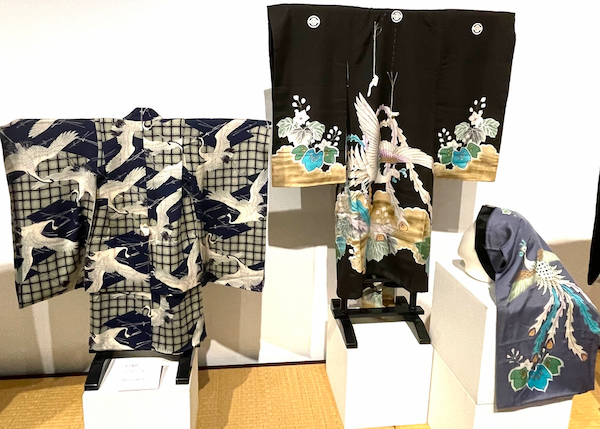
On this day, children wear special kimono.
Boys often wear designs with cranes (鶴:つる), bamboo (竹:たけ), and other motifs.
Cranes symbolize long life, health, and happiness.
And bamboo means strength and resilience, just like its straight and flexible growth.
Girls usually wear floral designs.
Patterns of cherry blossoms (桜:さくら), plum blossoms (梅:うめ), peonies (牡丹:ぼたん), and other flowers are common.
These flowers express wishes for beauty and a happy future.
Children’s Kimono
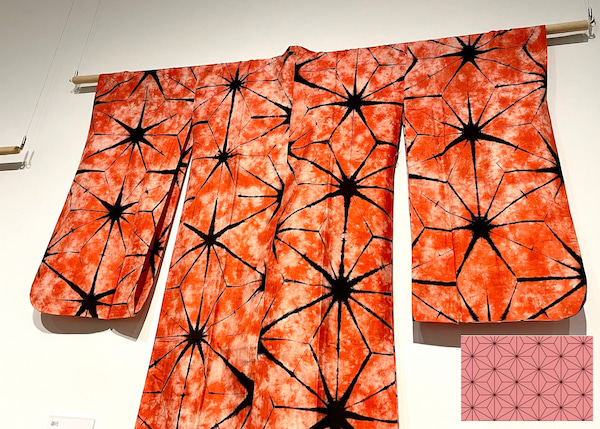
Another children’s kimono displayed had a very familiar pattern.
It was the asanoha monyo (麻の葉文様:あさのはもんよう), the hemp-leaf design.
Fans of the anime Demon Slayer: Kimetsu no Yaiba (鬼滅の刃:きめつのやいば) will recognize it as the pattern worn by Nezuko (禰󠄀豆子:ねずこ).
We often see this design as digital patterns on a computer.
But it is rare to see it on an actual kimono. The real fabric is not perfectly uniform.
And that irregularity gives it a natural charm.
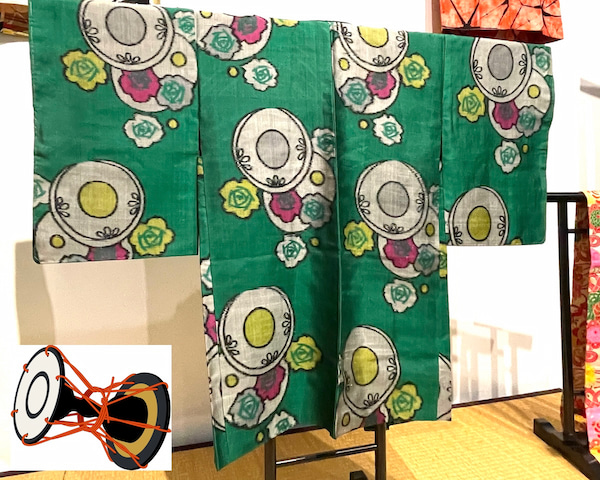
Another kimono displayed a drum called tsuzumi (鼓:つづみ).
Fans may recall it from Demon Slayer character Kyogai (響凱:きょうがい).
The tsuzumi is a small drum. You carry it on the right shoulder, support it with the left hand, and strike it with the right hand.
Influence of Taisho Roman (大正ロマン:たいしょうろまん)
Taisho Roman refers to the unique cultural mix of Western influence and Japanese tradition during the Taisho era (1912–1926).
Many obi and kimono from this time reflect this style.
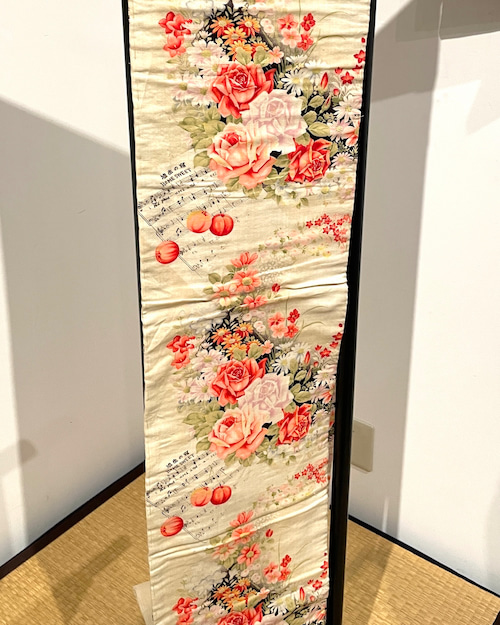
For example, one obi showed a musical score and roses.
The five-line staff notation came to Japan in 1823 with Dr. Siebold, who also brought a piano.
Roses also came from the West, but they began to be cultivated seriously in Japan during the Meiji era.
Formal Kimono (晴れ着:はれぎ)
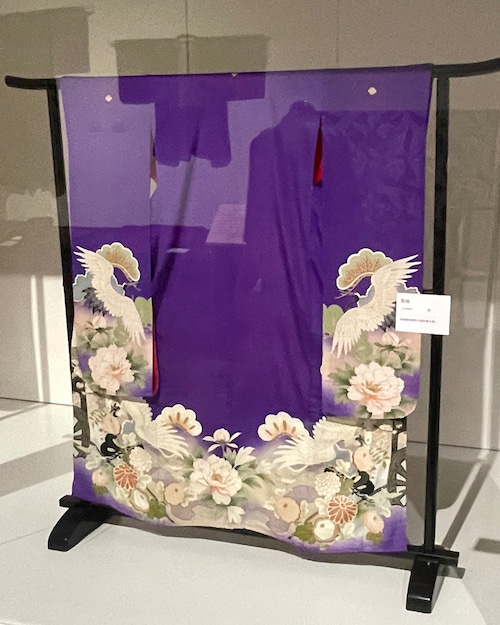
“Haregi(晴れ着:はれぎ)” are kimono worn on special days, such as the Coming-of-Age ceremony, weddings, and Shichi-Go-San.
The word hare (晴れ) means a bright or festive day, a day that is special in life.
One furisode (振袖:ふりそで) still showed a vivid purple color.
Purple represents nobility, dignity, and spirituality.
Prince Shōtoku (聖徳太子:しょうとくたいし) established the Twelve Level Cap and Rank System (冠位十二階 :かんいじゅうにかい) in 603.
And in that system, purple was the highest rank. It is a striking and elegant color.
Everyday Kimono: “Uchi-ori” and “Saki-ori”
Everyday kimono were more modest.
One type was uchi-ori (うち織り:うちおり), woven from waste cocoons that could not be sold.
Another was saki-ori (裂き織り:さきおり), made by cutting old cloth into strips and weaving them into new fabric.
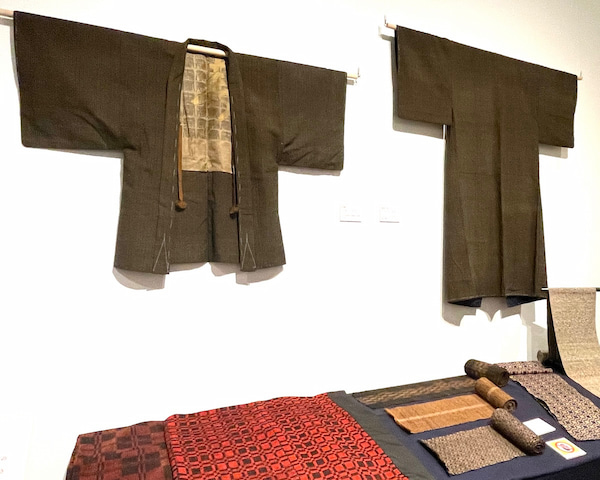
The two examples shown were for men. On the left was a haori (羽織:はおり), a jacket worn over a kimono.
On the right was an everyday kimono.
I had seen such items only in black-and-white photos. But this was my first time seeing the real thing.
The colors were rich. Shades of brown mixed with red tones and black, giving a deep and warm look.
Summary
Kimono has now become a special presence.
It is also one of the most iconic forms of traditional Japanese clothing.
And through an authentic kimono, you can feel the daily life of the Japanese people. You can also sense their unique idea of beauty.
This awareness, like the kimono itself, may have been passed down from parents to children.
And then from children to grandchildren. It is truly part of Japan’s cultural heritage.
Therefore, this exhibition offers a rare chance to experience traditional Japanese clothing.
It also lets you connect with cultural heritage that is slowly disappearing from everyday life.
I strongly recommend seeing the kimono in person.
But if you cannot visit, I have included many photos. So I hope you will enjoy them and still feel the charm of these historic garments.
These photos are used with permission from Silk Fact Okaya.
Learn about the Taisho era behind these kimono patterns in Taisho Era (大正時代) Values in Demon Slayer: Inheritance and Tradition.
You can also read about kimono and yukata, their differences, traditions, and cultural meaning in Japan. Kimono vs Yukata
The KIMONO COLLECTION exhibition is being held at Silk Fact Okaya.
You can visit their official website to learn more: Silk Fact Okaya
Japanese of the Day / 今日の日本語
- Word:晴れ着 (haregi) – ceremonial kimono
- Meaning:Haregi is a special kimono worn on celebratory occasions such as Shichi-Go-San (七五三), Seijin-shiki (成人式), and weddings.
It symbolizes joy, tradition, and milestones in life. - Example:成人式の晴れ着はとても華やかでした。(Seijin-shiki no haregi wa totemo hanayaka deshita.)
The haregi at the Coming-of-Age ceremony was very gorgeous. - Fun Fact:The word hare (晴れ) means “special” or “celebratory,” while gi (着) means “clothing.”
It contrasts with ke (日常, ordinary days), showing the Japanese idea of special days vs. everyday life.
◆ Would you like to talk about Japanese culture? ◆
In the Culture Course, you can learn to speak about Japanese culture with me.
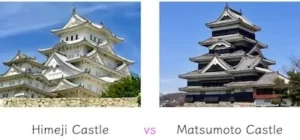
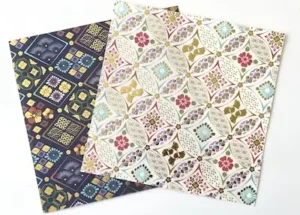
明治・大正・昭和時代の着物
先日、長野県岡谷市シルクファクトOkayaにて「KIMONO COLLECTION 受け継がれる絹の文化」展を見に行ってきました。
岡谷市はおよそ100年くらい前、シルク産業が盛んでした。当時の研究がされ、そのときの様子を知ることができます。
そして、今、明治時代から昭和時代の着物が展示されています。
100年以上前の着物ですが、保存状態がとてもよく、着物を通して当時の様子を知ることがきます。
特に、紫色の着物のあざやかさが今も私の記憶に鮮明に残っています。
今では当時の着物を見る機会が少なくなり、昔の着物が状態よく残っているというのはとても貴重です。
現代と昔の着物事情
今の日本では、着物を着る機会はあまり多くはありません。
七五三や成人式、結婚式など特別な日の装いとして着ることがほとんどです。
また、着物は親から子供へ、子供から孫へ引き継がれることも多いです。
そのため、成人式に母親の「振袖」を着る人もいます。現代の着物の柄は、花柄でもどこか西洋的な要素を感じます。
しかし、日本では数十年前まで、祝いの日はもちろん、日常的に着物を着ていました。
お祝いの日に着る着物の多くはシルクで作られていますが、日常着では綿のものが多いです。
いろいろな柄がありますが、和を感じるものが多く、古いけど新しい。と感じます。
展示会で見た着物の種類と印象
子供の晴れ着
日本では、男の子は5歳、女の子は3歳と7歳のときに、七五三というお祝いがあります。
子供の成長に感謝し、これからも健やかに成長しますように。という願いが込められています。
そのときに着る着物です。
男の子は「鶴」や「竹」の柄が入っているものが多いです。鶴は長寿、健康、幸福などの意味が込められています。
また、竹は、竹のようにしなやかにまっすぐ、力強く生きてほしいという意味が込められています。
女の子は花柄が多く、「桜」「梅」「牡丹」などが使われます、美しく育ってほしい、幸せになってほしいという願いが込められています。
子供の着物
こちらの子供用の着物は、アニメ『鬼滅の刃』の禰󠄀豆子(ねずこ)が着ている着物の柄です。「麻の葉文様」といいます。
パソコンでパターン化したものを目にすることはありますが、実物に着物に使われていたものを見る機会はなかなかありません。
実際の柄はいびつでどこか「味」があります。
こちらの着物は『鬼滅の刃』の響凱(きょうがい)という鬼が持っている「鼓(つずみ)」が描かれています。
和太鼓はいろいろな種類があります。その中でも、この「鼓」は小さく、右肩に掛け、左手で支えて、右手で叩いて音を出します。
大正ロマンの影響?
大正ロマンとは、大正時代(1912〜1926年)に西洋文化と日本の伝統文化が融合した独特の文化や社会現象のことです。
これらの帯や着物の柄はまさに大正ロマンの影響を受けているのではないでしょうか。
こちらの帯ですが、楽譜とバラの花が描かれています。
五線譜の楽譜は1823年医師のシーボルトがピアノを持ち込み、そのときに一緒に入ってきたと言われています。
また、バラも西洋から持ち込まれましたが、日本では明治時代に本格的に栽培が始まったそうです。
晴れ着
「晴れ着」とは成人式、結婚式、七五三などの「晴れの日」に着る着物です。「晴れの日』とは「人生において特別な日」のことです。
こちらの振袖は今も紫色があざやかに残っています。
紫色は「高貴」「気品」「精神性」を示す色です。聖徳太子が制定した冠位十二階(603年)の最高位にあたいします。
目を惹くとてもすてきな色です。
普段着に使った「うち織り」と「裂き織り」
普段着は、「うち織り(うちおり)」と呼ばる、売り物にならないくず繭を使って作ったもの。
それから「裂き織り(さきおり)」と呼ばれる、古くなった布を裂いて緯糸に使った織物。の2種類がありました。
写真の2点はいずれも男性用のものです。左側は着物の上に着る「羽織り」、右側は普段着の着物です。
どれも白黒写真では見たことがありますが、現物を目にするのは初めてでした。
色味も茶系の中に赤っぽい色や黒っぽい色が混ざり、深みのある色合いでした。
まとめ
着物は今や特別な存在になりました。
そして、実物の着物からは日本人の生活や美意識を感じられます。
その意識は着物と同じように、親から子へ、子から孫へ受け継がれているのかもしれません。
こちらの展示会では、失われつつある日常の文化に触れられる貴重な機会です。
ぜひ実物を見ていただければと思います。
(こちらの写真はシルクファクト岡谷様に掲載許可をいただいています。)
これらの着物柄の背景にある大正時代については、「Taisho Era(大正時代) Values in Demon Slayer: Inheritance and Tradition」をご覧ください。
着物と浴衣の違いや、日本での伝統や文化的意味についてはこちらの記事 Kimono vs Yukata でご紹介しています。
「KIMONO COLLECTION」は シルクファクトおかや で開催されています。
詳しくは公式サイトをご覧ください:シルクファクトおかや

